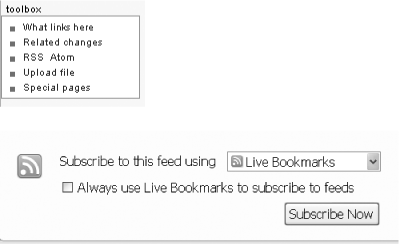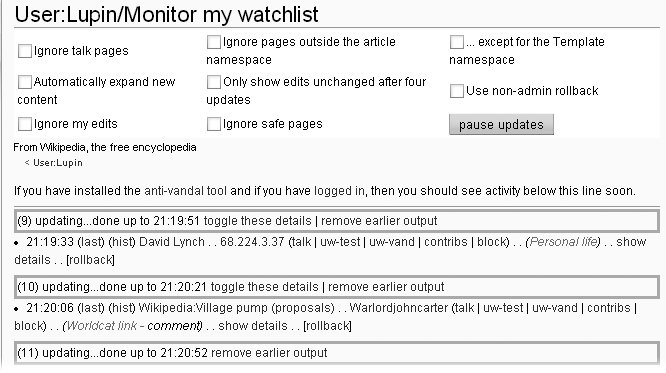All the watchlist reports described so far in this chapter are snapshots of edits at a moment in time. Their information is current as of when you create the report, but they don’t update themselves as edits are made. If you want to watch edits as they occur, consider receiving real-time updates for pages you want to watch. You use either standard Web feeds, or monitor changes to pages on your regular watchlist using Lupin’s Anti-vandal tool (Lupin’s Anti-vandal Tool).
Wikipedia supports two kinds of Web feeds: RSS and Atom. A Web feed is an automated way to get copies of changes to Web pages of your choice. For example, you can sign up to get new postings to a blog, saving you the trouble of checking the blog every day. You read such notifications in a feed reader—also called a feed aggregator or just an aggregator—a specialized application on your computer.
For RSS and Atom, you have two choices. The standard way is subscribe to individual pages. But you may also be able to use a feed to get notification of changes to your watchlist, although none of the three options for that are well-developed (see the box on Standard RSS and Atom feeds).
The most straightforward way to get a Web feed for pages you want to watch is to subscribe on a page-by-page basis to those pages. As with additional watchlists (Creating Additional Watchlists), if you want to watch both a page and its associated talk page, you have to subscribe to each separately. The links for the RSS and Atom feeds are available on each page’s page history tab. Click the “history” tab and look for the link on the left side of the screen (see Figure 6-11).
Figure 6-11. Top: To request an RSS or Atom feed for a specific article or other page, click the “history” tab for that page, and then look at the toolbox on the left side of the screen for a link to click : Bottom: Once you click either “RSS” or “Atom”, what you see depends entirely on your browser. Shown here is the top of the page of what Firefox 2.0 (on Windows XP) displays.
To subscribe to the page, click either the RSS or Atom link. Your browser then gives you the option of subscribing (exactly what you see depends on your browser).
Keep in mind that Wikipedia’s Web feeds include only the changed part of a page—in other words, the top part of a standard diff. That keeps the size of the text being sent via the feed to a reasonable amount, but it means that you can’t see what the entire article looks like after the edit occurred. (If you do want to see the full diff, just click the link at the bottom of the item in the feed.)
Tip
You’ll find more information about RSS and Atom feeds at the page Wikipedia:Syndication (shortcut: WP:XLM).
While there’s no easy way to set up a feed for your standard watchlist, any additional watchlists you create are a different matter. The Special:Recentchangeslinked page (click the Related changes link on the left) has an RSS/Atom feed. That means it’s easy to monitor changes to your additional watchlists in real time, if you want to.
Lupin’s Anti-vandal tool is the only solid real-time monitoring tool that uses your existing watchlist. This tool, described on the page User:Lupin/Anti-vandal tool, is a script (see Chapter 21) intended primarily for vandal-fighting, but you can also use it to identify spelling errors. More to the point, one of the vandal-fighting options is to use the tool to monitor changes to pages on your watchlist. As shown in Figure 6-12, you get a list of changes, plus checkboxes at the top that let you choose what kinds of edits you want to see.
If you don’t have many pages (or many active pages) on your watchlist, you might end up scrolling for pages and pages before you see any entries for editing activity. To put it numerically, this tool reports on edit changes every 30 seconds. Let’s say that your expanded watchlist report showed 24 changes in a 24-hour period—one change per hour. For that same 24-hour period, this tool would show at least 2,856 status reports with no activity, and 24 or fewer status reports with one or more edits.
Figure 6-12. The User:Lupin/Monitor my watchlist page has a scrolling list of edits of pages on your watchlist. At the top are a number of options. For example, you might want to turn on “Ignore talk pages” and “Ignore because pages outside the article namespace” because you’re focusing solely on vandalism to articles themselves.
Implementing this tool is very straightforward:
Copy the one-line script importScript(“User:Lupin/recent2.js”); to your monobook.js file, and then save the change.
See Chapter 21 for details about implementing user scripts.
The keystrokes vary by browser, but Ctrl+F5 for Windows, ⌘-F5 for Mac generally works.
You should see five new items in the “toolbox” set of links on the left side of the screen (see Figure 6-13). When you click the “Monitor my watchlist” link in Figure 6-13, you go to the User:Lupin/Monitor my watchlist page in Figure 6-12.
Figure 6-13. After you install Lupin’s Anti-vandal tool and purge your cache, your “toolbox” (on the left side of the screen) has five new links. You use the “Monitor my watchlist” link to get a real-time display of changes to pages in your watchlist.
Note
Three potential alternatives for real-time information aren’t available as this book goes to press: An Internet Relay Chat (IRC) feed of page changes limited to pages on your watchlist; an Instant Message (IM) feed (of any type); and email notifications of page changes. The last of these in fact is built into Wikipedia’s underlying software, but has been turned off in the English Wikipedia. (The English Wikipedia has roughly 300,000 edits per day, so this feature could potentially generate millions of outgoing emails every day from Wikipedia servers.)



